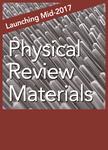版权所有:内蒙古大学图书馆 技术提供:维普资讯• 智图
内蒙古自治区呼和浩特市赛罕区大学西街235号 邮编: 010021

作者机构:Institute for Materials Science Faculty of Engineering University Kiel Kaiserstraße 2 24143 Kiel Germany Department of Aerospace Engineering and Mechanics University of Minnesota Minneapolis Minnesota 55455 USA Division of Engineering and Applied Science California Institute of Technology Pasadena California 91125 USA Department of Materials Science and Engineering University of Maryland College Park Maryland 20742 USA Mechanical and Aerospace Engineering The Hong Kong University of Science and Technology Clear Water Bay Hong Kong
出 版 物:《Physical Review Materials》 (Physic. Rev. Mat.)
年 卷 期:2019年第3卷第9期
页 面:093603-093603页
核心收录:
基 金:HK Research Grants Council, (16207017, 26200316) Institute on the Environment Medtronic Corp RDF fund National Science Foundation, NSF, (DMREF-1629026) National Science Foundation, NSF Office of Naval Research, ONR, (N00014-18-1-2766) Office of Naval Research, ONR U.S. Department of Energy, USDOE Basic Energy Sciences, BES, (DESC0016945) Basic Energy Sciences, BES Multidisciplinary University Research Initiative, MURI, (FA9550-16-1-0566, FA9550-18-1-0095) Multidisciplinary University Research Initiative, MURI Engineering and Physical Sciences Research Council, EPSRC, (EP/R014604/1) Engineering and Physical Sciences Research Council, EPSRC Deutsche Forschungsgemeinschaft, DFG, (313454214) Deutsche Forschungsgemeinschaft, DFG
主 题:Martensitic phase transition Ceramics Shape-memory materials
摘 要:The extraordinary ability of shape-memory alloys to recover after large imposed deformation motivates efforts to transpose these properties onto ceramics, which would enable practical shape-memory properties at high temperatures and in harsh environments. The theory of mechanical compatibility was utilized to predict promising ceramic candidates in the system (Y0.5Ta0.5O2)1−x−(Zr0.5Hf0.5O2)x, 0.6x0.85. When these compatibility conditions are met, a reduction in thermal hysteresis by a factor of 2.5, a tripling of deformability, and a 75% enhancement in strain recovery within the shape-memory effect was found. These findings reveal that predicting and optimizing the chemical composition of ceramics to attain improved crystallographic compatibility is a powerful tool for enabling and enhancing their deformability that could ultimately lead to a highly reversible oxide ceramic shape-memory material.